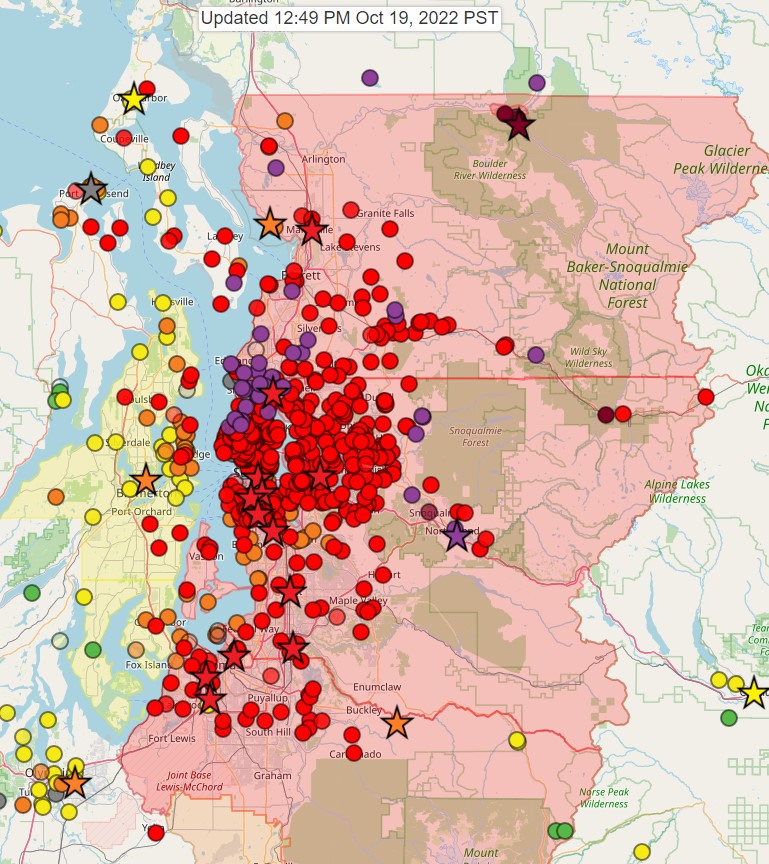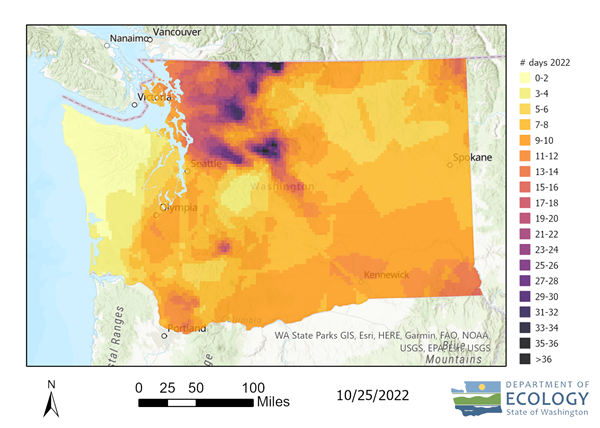
The Pacific Northwest rains finally arrived to wash away all the smoke. Now temperatures are dropping and some areas are already seeing snow. It’s like someone flicked the switch from summer wildfire smoke season to winter wood stove smoke season. What happened to fall...and come to think of it, spring?
Let’s review how 2022 wildfire smoke compared to previous years’ events. And, as we head into winter, review how smoke from wood stoves and those pesky weather events called "inversions" could still prompt Air Quality Alerts and Air Quality burn bans.
2022 wildfire smoke season in review
Summer sure got off to a late start this year because of the extended wet La Niña spring. But then, right on schedule, Excessive Heat Warnings and Advisories were issued near the end of July, and thus the wildfire season began with brush fires.
What would turn out to be the longest sustained wildfires started in mid-August, when lightning ignited the White River and Irving Peak fires, prompting Chelan County to issue evacuation orders.
By September, smoke from those fires, in addition to the Minnow Ridge, Goat Rocks, Bolt Creek, Kalama, and several other fires, began to smoke out residents on both sides of the Cascades.
Central and Eastern Washington were first warned of Air Quality Alerts on September 2, while Western Washington was first alerted a week later. Warm and dry conditions contributed to the growth of the Cascade fires, leading to closures of Highways 2 and 12 in Snohomish and Lewis counties. Winds shifted from east to west, and back again, starting a pattern that persisted throughout the month, with only periodic relief for Western and Central Washington. Air monitors on October 19, 2022.
Parts of Washington remained smoky throughout most of September and October. In fact, it was the first year that a significant wildfire smoke event affecting densely populated Western Washington had ever extended into October.
In early October, a high pressure system allowed smoke to affect Western Washington for a week. This resulted in moderate to very unhealthy air quality conditions, prompting Air Quality Alerts unusually late into mid-October. Relief finally arrived mid- to late-October, when the weather pattern shifted back to a westerly flow.
On October 18 and 19, it was widely reported that Seattle had the worst air quality of any major city in the world. As a whole, the state had one of the driest and warmest September/Octobers in recent history. That said, as of October, 140,000 acres of land had burned – the lowest amount since 2012.
2022 smoke compared to the last 8 years
The map on the left shows the average number of heavy wildfire smoke days from 2015-2021. You can really see how the eastern and central parts of the state have been impacted, with some areas averaging more than 20 days of wildfire smoke per year!
The map on the right is all about 2022. It’s obvious where the fires were that led to the "late, not-so-great" smoke out in Western and Central Washington and lingered right into October.
Average smoke impacts 2015-2021.
Average smoke impacts during 2022.
Smoke exposure by population
Another way to put this wildfire season into context is to look at how many Washingtonians were exposed to extended periods of unhealthy air in comparison to other recent smoke events.
The number of people exposed to unhealthy or worse air quality (daily PM2.5 average of > 55 micrograms per cubic meter) in 2022 is comparable to the smoke-filled days of 2017, 2018, and 2020.
One difference between 2022 and previous years is the duration of the smoke event. While the smoke lingered for much longer than we hoped this year, most Washingtonians were exposed to unhealthy or worse air for less than five days. A smaller fraction of the state (those located closest to active fires including the areas of Darrington, Leavenworth, and Wenatchee) were exposed to unhealthy or worse air for 10 to14 days.
The sudden switch to winter
Now that the summer smoke is over and cold conditions have abruptly snuck into the state, here are some things you should know about air quality due to winter smoke.
Using a wood stove
If you rely on burning wood for heat, use a wood stove that is certified in Washington. Selling or gifting non-certified wood stoves is illegal. Choose a stove that is the right size for your home and properly installed.
Help keep the air we all breathe healthy by following these tips:
- Burn only wood — Illegal materials include garbage, treated or painted wood, particle board, plastic, rubber, waste petroleum products, animal carcasses, asphalt products, paints, chemicals, or anything that emits dense smoke or unacceptable odors.
- Burn dry, seasoned wood — Use wood that has been split, covered, and stacked for at least 6 months or more. Dry wood burns hotter, uses less, creates less smoke, and saves you money.
- Let air in — Don't overfill your stove with wood or damp down your fire. This robs the fire of oxygen, produces less heat, wastes wood, and creates more smoke.
- Make the least possible smoke — A properly burning fire will emit very little smoke. Smoke from your chimney should be no more than 20 percent opacity (how much you can see through the smoke).
- Use a clean air fan — The clean air fan you used to keep indoor air clean during wildfire season also helps protect your respiratory health in the winter.
Air Quality burn bans
Air Quality burn bans typically occur during the winter when smoke from wood stoves reaches unhealthy levels. They are called by Ecology, local clean air agencies, and EPA calls burn bans on tribal lands. An Air Quality burn ban limits the use of wood stoves unless it is your only source of heat.
Before starting a fire, check to see if there is an Air Quality burn ban in effect.
There are two types of Air Quality burn bans:
- Stage 1 burn ban
- No use of uncertified wood stoves or fireplaces is allowed.
- No outdoor burning, agricultural, or forest burning is allowed.
- Stage 2 burn ban
- No burning indoors or outdoors is allowed, unless wood is your only source of heat.
Temperature inversions
Temperature inversions usually occur during the winter when air temperature warms at high elevation, trapping stagnant cold air and smoke near the Earth’s surface.
During an inversion, unhealthy levels of smoke from wood stoves and fireplaces may trigger an Air Quality burn ban, or even an Air Quality Alert, to protect public health.
Winter air quality resources
Stay informed of air quality conditions this winter by following Ecology on Twitter and Facebook and checking air quality monitors on the Washington’s Air Monitoring Network website, or by downloading the AirQualityWA app for Android or iPhone.
Check for Air Quality Alerts on the National Weather Service Watches, Warnings, or Advisories webpage.
You can also find tips on how to protect your health from wood smoke on Ecology’s Smoke health effects & burning alternatives webpage.
Stay warm and healthy this winter!






